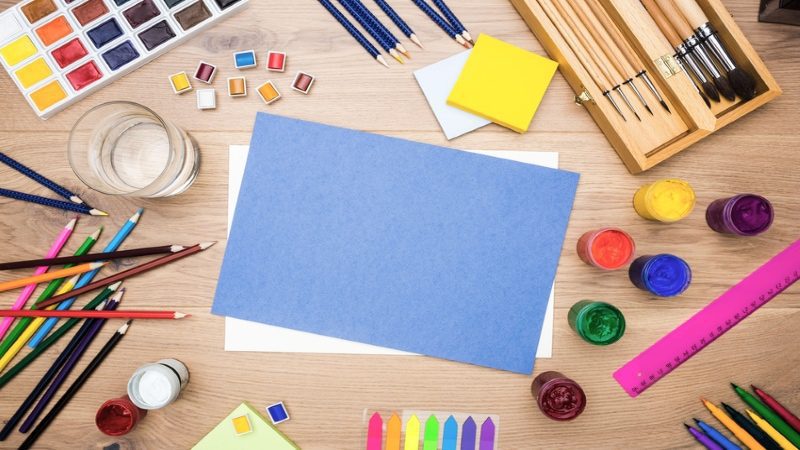Have you followed the recent adult coloring book trend? From mandalas and zentangles, to everyday nature scenes or inspirational word art, adults are rediscovering the joy of tuning in to the creative side of their brains. Coloring provides a relaxing, low-cost way to retreat from the pressures of everyday. Plus, breaking out all the old-school art supplies is just plain fun!
After spending some time coloring with friends over Christmas, I started wondering what it might take to create my own coloring book. I gathered books about learning to sketch flowers, creating my own zentangles, and designing my own typography. I watched videos about sketch-noting and creative lettering. And I quickly remembered how hard it is to transfer a picture from the brain onto paper! Even my best attempts looked rather amateurish.
But I was determined not to give up easily! I kept scouring the library shelves and picked up this art textbook on a whim… and it completely changed how I see things.
Instead of teaching you how to draw, it teaches you how to see things differently. Rather than simply giving step-by-step instructions for sketching faces and flowers, it teaches you how to notice edges, relationships, and shadows. It’s the difference between just seeing a hand or a tree – and noticing the specific shapes that make up the whole, the negative spaces that provide definition, the shadows that add depth, and the overall gestalt that makes the sketch seem comforting or menacing or humorous.
The best part is, as I learn to slow down and notice the details, my sketches are improving – without any innate talent or formal training. As I learn to see things differently, I’m able to describe them better, whether that’s with words or with pictures.
The interesting thing is how all of this relates to “the rest of life.” Learning any form of artistic expression (music, photography, poetry, sculpture, pottery, etc.) can have real-world application in the areas of problem-solving, team-building, and just thinking in general.
Why? Because it teaches you how to erase your preconceived ideas of how something looks, and shift your approach to observe the underlying connections and overall sense of a situation. It changes your perception of things, people, or situations.
For instance: have you ever tried drawing a realistic-looking nose? It’s hard to move past how you learned to draw noses back in fifth grade. But in order to draw a realistic-looking nose, you have to forget those preconceived ideas and look for the lines and the shadows and the relationship to other parts of the face.
That principle translates over to the rest of life. We approach challenging situations at work or in our personal lives with preconceived ideas of how to fix them – but how often does that approach actually work?
In life, as in drawing, we must look carefully to discover the shadows, connections, and boundaries.
In art, one way to train yourself to do that is by sketching an upside-down picture. That forces you to focus on the lines, spaces, and proportions rather than approaching it with preconceived ideas of “this is how a face should look.”
In the rest of life, that could mean taking a step back to consider the areas around a given problem:
- What underlying factors might there be (the “edges and spaces”)?
- How is it affecting other people or other situations (the “relationships”)?
- How “gray” of an issue is it really (the “shadows”)?
Here’s an exercise for you:
Consider a specific situation that’s been weighing you down. Approach it as though it were an art exercise. Observe the overall gestalt of the situation, notice the edges and negative spaces that define it, perceive the underlying shadows and connections that give it depth and relevance. Use an artistic medium as your guide – whether it’s drawing, scrapbooking, sculpting, writing poetry, or even composing music. The only limit is your creativity!
Now consider how that artistic medium helped you see the situation with fresh eyes. Did you discover some nuances that you weren’t aware of before? Did you identify some connections that brought the whole problem into focus? Did you realize a surprising depth to the circumstances that aided your understanding?
Tell me something! What’s your favorite artistic medium? Have you ever used it to help you solve a problem?
Image credit: feelphotoz

Elizabeth Johnson loves the color yellow, strong {black} coffee, editing, and exploring the mountains in rural Wyoming and Utah, where she and her husband serve as church planters. In her free time, she enjoys learning new things, hand-lettering and acrylic painting, and gaming with her husband.


Hey Elizabeth so glad you liked the journal.
I love colored pencils and doing calligraphy as well the two of them combined have enjoyed the two for years.
I am not to good at portraits I tend to make people look like someone else.
And I do have the adult coloring books they are quite fun sometimes just to relax a bit.
I have really never used it to solve a problem but the thought of using it to sort through a problem is a great idea. I always pray about it and ask God for His wisdom and strength through issues. Love Liz and the boys
Thanks Liz! I definitely still have a LOT to learn when it comes to drawing, but it’s been intriguing to make some connections like this to other areas of life.
I loved this post, Elizabeth – wonder if I’ll ever pick up a grown up coloring book myself!
You should! Although it’s pretty easy to find free printable pages on Pinterest – might let you get a better idea what styles you enjoy coloring before you go out and buy something.